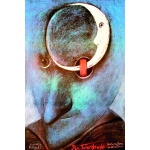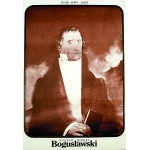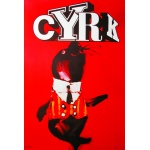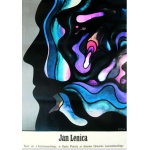From the end of the 1940s, a few Polish graphic designers,
Lipinski, Trepkowski, Tomaszewski and others have chosen
the beautiful poster as a support for popular education
in the language of art, and that of the symbolic poster,
to provoke intellectual reflection.
The Golden Age of Polish posters
---More than 30 years ago, the collapse of communism in Europe surprised us all, from the ordinary man on the street to the world’s politicians. Although manipulating information in the communist countries was commonplace if not the norm, we in the non-communist countries were also subjected to information which offered caricatures of the countries allied to Moscow, the “Evil Empire” as Reagan once described them, reducing these countries to a series of clichés which were simplistic and often inaccurate. Even after the fall of communism, these clichés have persisted and I have the impression that history has somewhat distorted reality.
---One of these clichés suggested that art was influenced by directives issued by the Party and that artists were required to follow aesthetic criteria which were clearly defined and controlled. The reality was at times very different in the various countries involved.
---As far as Poland was concerned, we should perhaps remember that the country was completely wiped from the map for over 150 years, carved up between Germany and Russia, and that it only continued to exist through its culture, language and religion. Poland was re-created as a separate country as recently as 1918. This perhaps explains the importance of literature and culture in the country and the aura surrounding artists and writers.
---This is the context in which Polish posters should be considered. Polish posters have existed since the beginning of the 20C, but when we talk about the Polish poster as an artistic movement we are referring to the period from 1955 to 1985. This was one of the most important periods of graphic art in the world and an essential point of reference for all young graphic artists of the time. The movement developed with a sense of creativity, fantasy and imagination, and therefore a freedom, which was completely unknown elsewhere.
---To talk about freedom of creativity in a communist country at this time sits uncomfortably with the Manichean idea that we have of communism, but the facts are clear – this freedom of creative expression existed in Poland and nowhere else. In an attempt to explain this phenomenon, I would say that economic censure was far more of a constraint that political censure. In this State economy, communication codes were beyond commercial logic and we only have to compare posters produced in Warsaw with those produced for the same film in the West to understand that the respective artists were not working under the same constraints.
---We might suppose that similar movements may have developed in other communist countries, but this is not the case – Poland was the exception. As always, this movement grew from the coming together of young artists who imposed their ideas of images by adapting their work to their particular location and period. The Polish poster is, therefore, the history of this group of artists taking power within existing committees and structures and a demonstration of their success in imposing and developing their original works of art outside of the conventions respected by the West or the communist aesthetics defined by Moscow.
---The Polish poster was born from the hope of these artists in a new world, using the poster as a media tool (which was by definition working class) in order to educate people in the language of art and to provoke an intellectual response.
---It is wrong to talk about a “Polish poster” style, as the only common feature of the artists within this movement was their freedom of creative expression, and their ability to liberate themselves from any typographical or graphic codes. This freedom means that forty years later posters by Tomaszewski remain remarkably contemporary in style. Each artist developed his own particular language – the style of Lenica cannot be confused with that of Swierzy, neither can the style of Starowieyski be confused with that of Cieslewicz, to mention just a few.
---Another particular feature of the Polish poster is that it was above all a street phenomenon. Although only around a dozen of these artists, perhaps fewer, will be remembered by name, we should not forget that all of these posters, the good ones along with the mediocre, reflected this difference, this freedom and creativity. Foreign visitors arriving in Warsaw were immediately struck by the colourful vibrancy of the posters, which provided a sharp contrast with the city’s grey architecture. It took a while to get past this impression of an overall ensemble of art and to establish a hierarchy of values; the media tool which became status-enhancing attracted the best artists, which in turn created a sense of competition and emulation. The Polish State, aware of the international success of the Polish poster, encouraged the creation of the first international biennale event, a reference for the forty or so events of this genre which take place around the world, as well as the first museum dedicated to contemporary posters.
---Like any artistic movement, that of the Polish poster is very much linked to its own time and place, so that its development, expansion and deterioration act as a reflection of the political system whose absurd nature foreshadowed its forthcoming collapse.
---With the fall of communism the structures of the state fragmented, including the Polish School of Poster Art. The “Polish poster” became a shadow of its former self, not because its great artists, now grown old, no longer produced fine works of art, but because the energy and feeling of utopia had disappeared and no longer had the same meaning for the younger generation. Nearly all the major artists quietly disappeared and now the names of Zamecznik, Mlodozeniec, Lenica and Tomaszewski belong to history.
---The Polish poster and its artists have not been a reference point for young graphic artists for some time now. Unfairly, history has retained the names and images of just a few artists, and always the same ones at that (“Moore” by Tomaszewski, “Wozzeck” by Lenica etc), eclipsing others who contributed to the reality and strength of this movement. At the same time, works by Tomaszewski risk being moved from the history of Graphic Art to that of Art in general, so that this artist would then appear alongside another emblematic figure of poster art, Henri de Toulouse Lautrec.
-
Presentation of the Wilanow Museum,
the world's first poster museum, opened in June 1968








